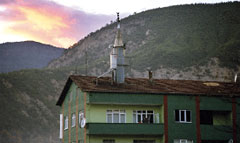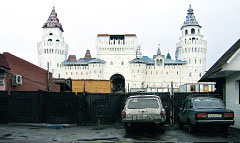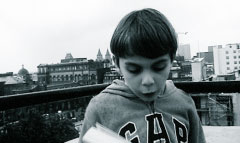![]()
![]()
Open Space - Zentrum für Kunst Projekte opens its
door to the public with The Temporary Zones a stimulating
first project developed by the founder and director of Open Space, Gulsen
Bal. The exhibition offers a space for exploration of current
relations of and in predicated conflict and negotiation within cultural
specific conditions. In pointing out the space of current relations, the
scope of the project allows an engagement of a space that identifies the
transitional conditions and the flows where the temporal construct seemingly
obliterates all its secrets and ambiguities. In a passage of an unstable
world, this gives a moment of magnitude by tracing the cross-border dialogues.
Each participating artist creates works that respond in particular ways,
to take a deeper look at complex relational powers, with a new conjunction
of transitions in a designated quasi-accessible space that resides within
the creative practice.
In conjunction with the exhibition, a panel discussion is planned to address
these issues with the participating artist.
Activities
• Exhibition in ways which consider the new presentation models
• Artist talk chaired by Gulsen Bal with an introduction
by the director of LABfactory Thomas Jelinek
Ergin Çavusoglu
Peter Mörtenböck / Helge Mooshammer
Nada Prlja
Curated by Gulsen Bal
Sponsored and kind support provided by:
Interkulturelle und internationale Aktivitäten
LABfactory
IB-Office Consulting
Monochrom
Wien Kultur

Empire (after Andy Warhol), 2007
Single channel video, Sound
Running time:: 26:04 Minutes, Continuous loop
Ergin Çavusoglu is known for his lyrical and unsettling video installations that reconstitute our sense of space, and pose questions about our understanding of place and identity in a globalised society marked by mobility.
His recent single channel video Empire (after Andy Warhol) reframes an ordinary building in reference to the representation of an iconicized structure, while shifting from the global to the local. Borrowing his title from Andy Warhol's film ‘Empire’, which consists of a single shot of the Empire State Building and runs 8 hours and 6 minutes and chronicles the passage from day to night, Çavusoglu’s video rather echoes the 'space of current relations', associated with notions of temporal and spatial continuity in which the concepts of domestic comfort are unsettled through an unrelenting gaze.
Çavusoglu’s film captures in a static shot the transition from day to night surrounding a residential apartment block, thus reframing the extant strangeness of a minaret rising through the roof of the apartment. The flats in the block, built a quarter of a century ago in Karabük (Turkey), remain occupied and the main part of the mosque with the prayer room for worshipping is situated in the basement of the apartment.
Illuminating light abruptly goes dark, generating a different register through a moment of interruption where we witness something different, ‘another truth’.

Visiting Stalin (Zu Gast bei Stalin), 2007
Photography and drawings
In their work, Peter Mörtenböck and Helge Mooshammer reflect upon cultural transformations of our contemporary world through exploring the potentials and effects of networked spatial practices. Departing from sites of geopolitical conflicts and social confrontations they seek to conceptualise the knowledge embodied by these new forms of socio-spatial organisation and group action. In doing so, they raise questions how the emergence of networked cultures has changed our cultural forms of cohabitation and communication, and how we produce and experience the spaces we live in vis-à-vis a globalised world of flows.
The text-supported photo story Visiting Stalin assembles the visual signs and symbols of cultural hybridisations and economic superimpositions in a global city like Moscow.
Visiting Stalin follows the myriad stories and histories around the site of the former Stalinets Stadium in Moscow-Izmailovo that today forms the empty inner zone of the sprawling Cherkizovsky Market. Three times the size of the Moscow Kremlin, the market supports Russia’s new millionaires as well as thousands of migrants from Tajikistan, Uzbekistan, China and extended Southeast Asia, who have come to seek work as stall-minders, carriers and tea-sellers. The project explores how markets function as a dynamic force that generates new forms of collective exchange, and how this process relates to the aesthetics of establishing new social orders.
Although these experimental structures are highly unstable, they leave their mark on the fabric of the city. They transport images, ideas and values between different worlds. And with their improvised technologies, infrastructures and spatial policies, they create openings for new urban situations and new links between the local and the global levels.

The Rights, 2007
Multi channel video, Sound
Running time: various
THE RIGHTS, I AM MACEDONIAN, THE RIGHTS, I AM ROMANIAN, THE RIGHTS, I AM TURKISH, THE RIGHTS, I AM SERBIAN, etc.
The Rights is a series of video recordings of children who are reading 'European Convention for the Protection of Human Rights and Fundamental Freedom' in the manner it presents that there is no protection of human rights and freedom. This exposes the complexity of the issues of immigration and the EU politics around the boundaries of ‘New Europe'.
Prlja creates a space that identifies the transitional conditions in between new topological zones of exclusion and inclusion through focusing on the culturally specific conditions. The Rights engenders the potentiality in the course of absorbing the results of its transformative capacities where the cultural objects are produced within a paradigm of introducing everyday settings. This inquiry puts across a disjointed temporality which exposes the ambiguity of the situation. Thus the issue introduced here refers to an experimental dynamic outside representational boundaries that define the conjuncture of social forces beyond its discursive construction encapsulated in the midst of “who speaks”.
The space of current relations brings us to draw an attention to a generative process of differential structures affected by a transitory characteristic, the “in-between-ness”. An uncertain transition, as it appears in The Rights, provokes an encounter with a situation to a norm extrinsic to that situation at the edge of a certain representational matrix while dramatically capturing the moment that mirrors the “other” of Europe by way of its multitude of particular identities.